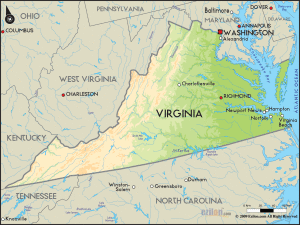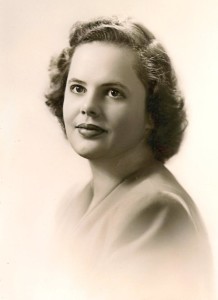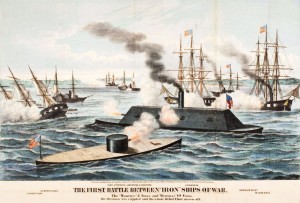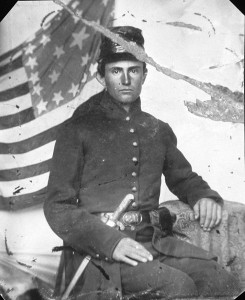
Preface: (by Mark Arnold) The true story presented here was written in March of 1924 by Mary Middleton Wrenn, my great grandmother on my mother’s side. The Wrenn family has a long history in America and specifically the state, and before that colony, of Virginia, going back to the 1600s. Mary Middleton Wrenn was born in 1858 and died in 1942. She was a member of the “Daughters of the American Revolution” and the “United Daughters of the Confederacy” and was 3 years old at the start of the Civil War, which is the setting for this story. In the story she makes mention of the city in which she lived being close to the Navy Yard at which the famous Confederate ironclad “Merrimac” was built. That would make her town most likely Norfolk or possibly Portsmouth, Virginia on the southern shore of the James River near the river’s mouth on Chesapeake Bay. Mary also refers to the battle between the Merrimac and the Union ironclad “Monitor” (called the Battle of Hampton Roads, which is the name of the body of water on which the battle was fought) which took place in early March 1862. Though the battle was a standoff it is regarded by some as a tactical victory for the North because the Monitor prevented the Merrimac from carrying out its mission of breaking the Union blockade of southern ports. Following the Battle of Hampton Roads Union troops occupied that part of Virginia as part of Union General George McClellan’s Peninsula Campaign in the late spring and summer of 1862; and Mary refers to her interactions with these occupying troops in her story. The story is presented as Mary, who was known to her grand children by the nickname “Grossie”, wrote it, and any errors in grammar or history are hers and not mine. As you can see, the story is addressed to Judy Bradford, who I believe was a cousin of my mother, Sarah Houghton Wrenn (who was 3 years old at the time it was written). I have no idea why it is entitled “When She Had the Chicken Pox” as the disease is not referenced once in the story. As a genuine, firsthand account, however, of a slice of history that we can ordinarily only read about in history books, I got a real kick out of it. I hope you do too. MA

March, 1924
TO JUDY BRADFORD
When She Had the Chickenpox
You have read of the Court of King Arthur and the Knights of the Round Table; and Merlin and Bors; and Launcelot and Elaine; Gareth and Lynette; and Percival, who came so near seeing the Holy Grail; and Sir Galahad,[1] the only one who did. You have also read of the Little Maid of Ticonderoga who helped to win the Battle; and the Little Maid of Provincetown.[2] Now I am going to tell you of a wee little girl in Virginia.
This little girl, and her name was Mary, was only three years old when there was a great war between the North and the South; that is between New York and Virginia. Nearly all the young men had gone to fight, and Mary’s father went too, leaving Mary, her baby brother and older sister with her mother, grandmother and cousin Martha. Grandmother and Cousin Martha came to live with Mary’s mother when the war began. Everybody living in Virginia wanted the South to win the war. The colors of the South were red, white and red [3]; and nearly everybody wore a rosette or badge of red and white ribbon. Mary’s grandmother trimmed Mary a rolling hoop, bound it all around with red and white and crossed the red and white through the middle. Though Mary was not large enough to roll the hoop very well, she used to love to have it to play with.

Everybody was just as busy as they could be helping to try to win the war. Near the city was a Navy Yard where big boats were made. One of these boats the workman covered all over with iron, and this was the first iron battleship, and was called the Merrimac. After the Merrimac was finished and went out of the Navy Yard, there was a dreadful battle. She fought well and caused many big ships to sink, but finally she was overcome by a curious little boat called the Monitor.[4] After this the city was filled with Northern soldiers. The Navy Yard was burned and people could no longer act as freely as they did. Mary didn’t know this. She took her hoop as she had always done, and went out to play. She was sitting on the front steps and a Northern soldier came along, snatched the hoop from Mary’s hand, broke it up, struck a match and burned it. Mary was dreadfully distressed and went in the house crying. Her grandmother then made her a little flag and put it on a stick for her to play with. This made her very happy and she went off playing with it, when along came another Northern soldier and treated the flag the same as the other one did the hoop. Poor little Mary after this never ventured again to take anything red, white and red on the street.
Her mother and Cousin Martha were just as busy as they could be sewing; making curious looking petticoats they called them, out of red flannel and gray cloth. They told Mary that they were going to take her to see her grandfather who lived far away in the country. Mary was very happy for she loved to go to the country, but she thought it very funny that her mother and cousin Martha should wear such heavy petticoats, for it was still summer. So they all got ready and at last the day came for them to start. Though interviewed many times by the Northern soldiers, they managed to reach grandfather in safety; and who should be there but Mary’s own father who was allowed to leave the army for a short time. And then Mary found out what the red flannel and gray cloth was for; it was to make winter clothes for her father, and they couldn’t take it to him any other way. The Northern soldiers wouldn’t let them.

Mary always had a wonderful time at her grandfather’s. There was a large yard with many big trees, a flower garden with roses, hollyhock, jacky jump-abouts, larkspur and all sorts of flowers that Mary could gather as she wished, and nearby was the orchard with the trees filled with apples and peaches. Near the orchard was a still, and the men were busy crushing apples for cider, vinegar and brandy. There were barrels and barrels of cider there at the still, and Mary just loved to go there and drink the cider through a long straw right from the barrels. There were two little children, Fanny and Jinny, on the place, besides many colored children. The colored children could only play with the little white children by waiting on them and doing what they told them to do.
Mary hated to leave, though summer was gone and they couldn’t play out as long in the evening as they did. Her father had gone back to the army; yet there were so many things she had to give up. In mid-winter, after they had been back home for several weeks, one night a great number of soldiers came, surrounded the house, and searched the house from top to bottom, looking for a man that they wanted and thought he was hidden there some place. Then they made Mary’s mother dress and go with them. They put her in prison because they thought she knew where the man that they wanted was. But she didn’t know a thing about him. Next day Cousin Martha went to the prison to see Mary’s mother and took Mary with her and Mary stayed there in prison with her mother for nearly two weeks. She was a great pet with the Northern soldiers. They would take her with them to their mess hall or dining room, and it was then that Mary saw, for the first time, anyone eating pie for breakfast. They gave her many little things to play with and Mary was very happy and had a fine time, though she was in prison.
And this little Mary was your own Grossie!
Written by
Mary Middleton Wrenn
March, 1924
[1] Fans of King Arthur and the Knights of the Round Table will recognize Merlin and Bors, Launcelot and Elaine, Gareth and Lynette, and Percival and Sir Gallahad as key characters of the Arthurian legend.
[2] “A Little Maid of Ticonderoga” and “A Little Maid of Provincetown” are two of 10 or so historical fiction books for children and adolescents called the “Little Maid” series, written by Alice Turner Curtis and published between 1913 and 1937. They were popular at the time Mary Middleton Wrenn wrote this story in 1924.
[3] The Southern colors during the Civil War were, to my knowledge, red, white and blue. In the story Mary says they were red, white and red, and so it was left as she described. It is possible there were some local colors for the area she lived in not widely adopted by the whole South.
[4] The clash between the Monitor and the Merrimac at the Battle of Hampton Roads is more significant to history as the first battle the world had ever seen between ironclad warships. As such it is considered to have ushered in the era of modern warships built of iron and steel rather than wood.


4 Responses
Hi there! I’m at work browsing your blog from my new iphone!
Just wanted to say I love reading through your blog and look forward to
all your posts! Keep up the outstanding work!
Thanks for the kind words and I will keep the posts coming. MA
I am sitting with my 99 yr old mother with what appears to be an original of the story. Grossie was her grandmother. My mother is joan Felton Bradford – later Campbell. Her mother was Margaret wrenn Bradford.
Hi Victoria,
I m very pleased to find that Mary Middleton Wrenn’s original of this story is in your possession. Really glad your mom is still there to share it with you. If you don’t ming my asking, where do you folks live? Back in Virginia by any chance?